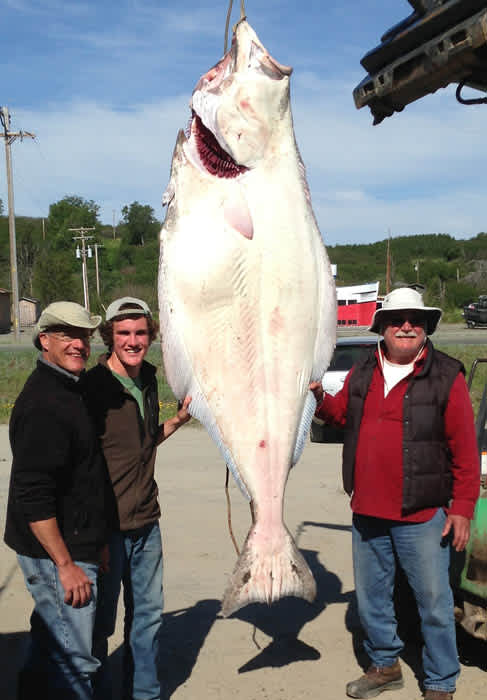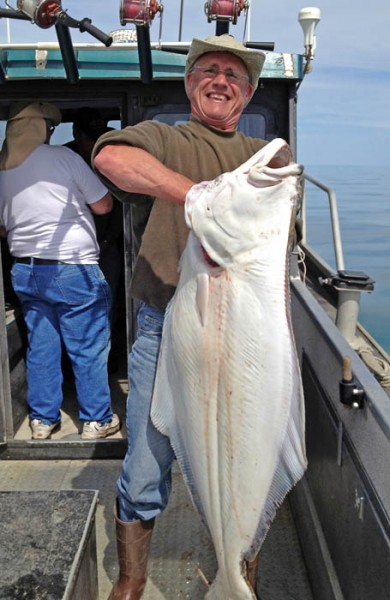Wisconsin Angler Lands 332-pound Halibut in Alaska
Patrick Durkin 08.21.13

When walleye fishermen can’t keep their bait near bottom in fast-moving rivers, they simply reel up, snip off their 1/4- or 3/8-ounce jig, tie on a 1/2- or 3/4-ouncer and get back to fishing.
Alaska’s halibut fishermen don’t have it so easy. When the ocean’s tidal currents sweep their baits far from bottom and away from feeding fish, anglers can’t quickly switch to heavier tackle. They must first crank up more than 500 feet of line and a five-pound weight.
Yes, their reel handle is big enough for a trailer winch. And yes, they can rest the rod atop the boat’s gunwale and brace it against a thick peg to keep it from sliding. But it’s a long day cranking all that gear to the surface, rerigging, and sending a weight back into the depths to keep bait in the halibut’s strike zone.
Just ask George Rather, 73, of Green Bay, Wisconsin. He performed that arm-numbing job so often on a recent trip to Ninilchik, Alaska, that he decided it’s labor best suited for younger men, specifically his son Jim, 54, and grandson Mason, 17, of Madison. Even so, on their third day of fishing on Cook Inlet with friends Don Wartick of Beecher and Bernie Zalewski of Lac du Flambeau, the elder Rather found himself fighting far more than five pounds of lead and powerful currents.
The halibut Rather landed June 18 weighed 332 pounds, and its body was large enough to nearly cover a 4×8-foot piece of plywood. Just imagine yourself trying to pry that powerful slab from 260 feet below the boat and up to the surface. Rather knows easier ways to spend 30 minutes.
“Almost all the fish we caught the first three days came straight up to the boat,” Rather said. “When the big one hit, I’d pull him a few feet up and he’d go right back to the bottom. I’d get him up about five feet again, and he’d go right back down again. About the third time that happened, the guide tightened the reel’s drag and told me to keep pulling.
“We had 160-pound line on the reel, so I kept the rod at a 45-degree angle and pulled. At one point I thought he got off the hook, but he was swimming west instead of heading for the surface. So I kept cranking. Then I thought it might be a sea ray, because we’d caught one of them each day. The rays fought much like my halibut.”
The Rathers were fishing from a 28-foot boat called the Viking Spirit, which is run by Free Spool Charters and its captain, Sam Forsberg. As Forsberg watched the rod tip and the way the fish pulled line off the reel, he decided Rather was fighting a big halibut.
“I kept thinking I was going to lose him,” Rather said. “That was a lot of work.”
Finally, the big fish tired, surfaced and turned sideways to the boat. When Rather pulled it within range, Forsberg harpooned it. Then he brought it alongside the boat and secured it with a rope through its huge mouth and gills.
“You could have put a football in that mouth,” Rather said.

When they quit fishing later, it took four of them to haul the fish over the boat’s gunwale and into its stern. Not only was Rather’s halibut the biggest caught by the group in three days of fishing, it’s also one of the best caught all summer in Alaskan waters.
The largest halibut registered so far in the nearby derby at Homer weighed 236 pounds, and was caught July 25. The largest Alaskan halibut ever landed by a sport angler weighed 459 pounds, and was caught in 1996 near Dutch Harbor.
Jim Rather caught the group’s next largest halibut, a 60-pounder. They released everything weighing less than 20 pounds. Each of the five men went home with 90 pounds of halibut meat, which is prized for its sweet flavor, flaky texture, and white color when cooked. Rather’s trophy halibut yielded 164 pounds of meat. They also collected cheeks from all their halibut, one-pound delicacies carved from behind the fish’s jaws.
“It doesn’t matter how old or large halibut grow,” George Rather said. “Their meat still has the same sweet taste. When we checked the price of fresh halibut in the stores up there, it cost about $20 per pound.”
But it’s meat well-earned. Each fishing day lasted 10 hours, from the time they left the harbor until they returned. Rather said halibut fishing is a constant challenge, starting from the boat launch itself each morning.
The charter boats don’t operate from permanent docks in protected harbors. Instead, they’re kept on trailers the owners hook to large tractors with wide, six-foot-high tires. The captain, crew and clients then climb aboard, and the tractor hauls them to the nearby beach. The tractor driver backs the boat trailer deep into the water to launch them.
From there, they took 15-mile boat rides each morning to reach the areas they fished, and then anchored. The tidal currents are so strong that the boat captain puts out 500 feet of one-inch thick anchor line in the 260- to 280-foot waters. Even when anchored, powerful currents push the boat so much that the captain must engage one of his 150-horsepower engines to keep the boat positioned.
For bait, they cut foot-long herrings into two or three pieces, and slid the chunks onto huge 18/0 hooks. They sometimes tipped their hooks with chunks of cod or flounder for extra scent. And to ensure the meat withstood as many bites as possible, they secured everything to their hooks with rubber bands.
After all, who wants to crank up five-pound weights and 600 feet of line just to rebait?

